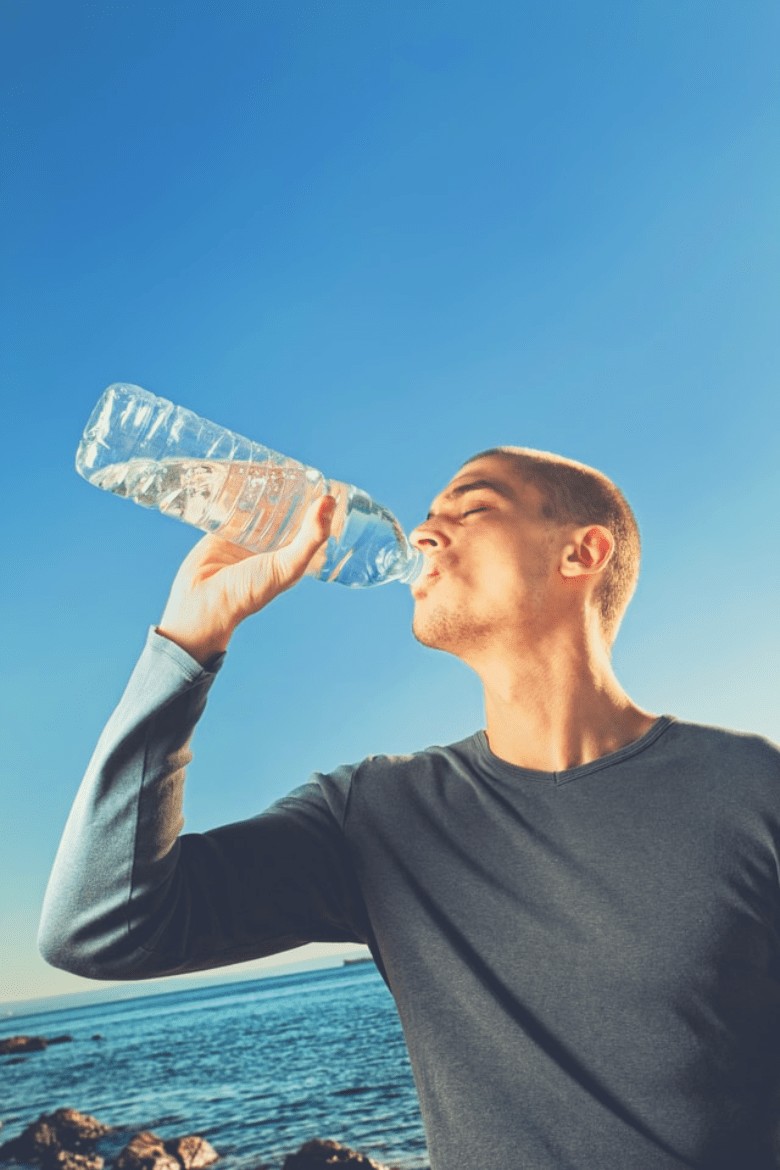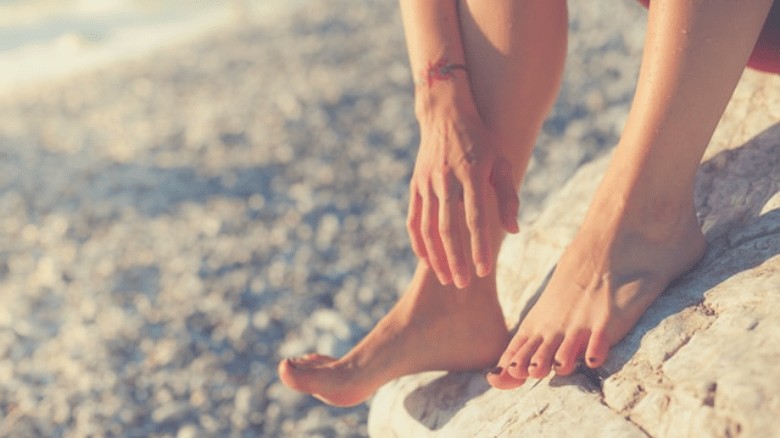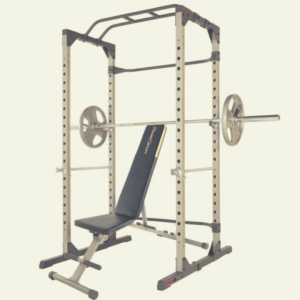We depend on our feet to get us where we want to go every day.
We may be on our feet all day at work and they’re tired when we get home, but we’re determined to get through our daily exercise routine.
Except, by the time we finish our exercise routine our feet are even more tired and achy.
Below we will discuss what causes foot fatigue, ways to handle your achy feet, other causes of achy feet that may intersect with exercise, and when to see your doctor about your foot aches.
What Causes Foot Fatigue?
Foot fatigue commonly happens when we walk or stand for long periods of time.
Foot fatigue is mainly seen in work environments where employees either walk or stand for long periods of time.
Such professions are factory workers, medical professionals, cooks, cleaners, and retail workers.
Standing at work all day isn’t the only cause of foot fatigue, runners often experience this as do those with abnormal foot structures.
Abnormal foot structures would include flat feet, high arches. Flat feet and high arches make muscles work harder, which then overworks the muscles in the foot, causing tired feet.
How To Handle Tired Feet From Exercise
There are several ways to take care of your tired feet after completing your exercise routine.
These include:
Using Arch Supports
You may not even realize you need arch support but it can still help, especially after exercising.
Arch support products provide support so the muscles in the feet don’t have to work as hard.
If they don’t have to work as hard to support the foot, then the muscles won’t become as sore or as tired as they usually do.
They provide support by evenly distributing pressure across the whole foot and providing stability and balance.
Arch support insoles also prevent damage to your feet that would otherwise occur without proper arch support.
Elevate Feet
Elevating your feet is a great way to make your tired feet happy. When your feet are tired and sore, they may also be swollen.
Elevating your feet, particularly if the elevation of the feet is above your heart, decreases any swelling you may have in your feet and legs.
This improves the flow of blood to your body and prevents blood from pooling in your legs or feet.
The recommended length of time to keep your feet elevated is anywhere from 10 to 30 minutes.
If your home lacks a recliner, some other ways to comfortably elevate your feet would be by using a stack of pillows or lay on the bed or floor and place your feet on the wall.
Foot Bath
Your feet don’t even have to be dirty or smelly to get a foot bath. Not only does a warm foot bath soothe muscles, thereby reducing and eliminating aches and pains, but it also helps to reduce swelling.
A bonus of soaking your feet in a foot bath is that it hydrates your skin, making your skin soft and smooth.
Warm water works great at encouraging increased blood circulation in the feet, particularly in combination with Epsom salt.
There are many benefits to Epsom salt, such as reducing swelling and foot pain, providing your body with more magnesium, and helping with constipation.
You can even add various scented oils for stress relief and other benefits.
Foot Massage
Sometimes the best thing you need at the end of a busy day is a good foot massage.
Not only do foot massages relieve achy, tired feet, but they also lower blood pressure, decrease depression, and help with headaches and migraines.
Not only that, but a good foot massage improves blood circulation, makes feet healthier, and provides a more peaceful sleep if done before bedtime.
Foot Strength Exercises
While a foot massage also helps prevent foot and ankle injuries, there are foot strength exercises one can do to help with achy feet.
You can either target one at a time or you can choose to target your entire foot.
Such exercises include heel stretches, heel lifts, picking up objects with your toes, or doing toe curls and arch lifts.
Hydrate, Hydrate, Hydrate

When it comes to keeping ourselves happy and healthy, there is nothing more important than staying hydrated and drinking enough water.
Proper hydration regulates our body temperature, keeps our joints lubricated, as well as improving our mood, cognitive abilities, and sleep.
If your feet are cramping, you may be dehydrated and low on electrolytes.
Other than water, the best things to drink for hydration are milk, tea, and juices with a low amount of sugar. Stay away from alcohol, soda, coffee, or drink with added sugar or caffeine.
Ice Your Feet
Instead of dipping your feet into a warm foot bath, the next best thing you might want to do is ice your feet instead.
There is a reason ice is used in an injured area. Icing decreases blood flow to an area, which decreases pain, inflammation, and swelling.
Don’t put the icepack directly on your feet as that causes frostbite, but fill a plastic bag, wrap a washcloth around it and place it on your foot, or place your foot on the bag.
The recommended length of time for icing your feet is 15 minutes.
Night Splints
While they would, undoubtedly, take some getting used to and be a little uncomfortable at first, night splints go a long way in reducing foot fatigue.
Not everybody naturally sleeps with their feet at a 90-degree angle, a neutral foot to leg angle.
The plantar-flexed position that most people sleep in actually shortens the plantar fascia. If you ever had foot pain or tenderness after a restful night’s sleep, this is most likely why.
Stretch The Calves
Tight muscles and misalignments in one part of the body cause pain and havoc in other parts of the body.
A misaligned hip can cause headaches, or foot pain, a bump to a nerve in the elbow causes tingling in the hand and down to the hip. In this manner, tight calf muscles can also cause sore or tired feet.
To remedy this, find a calf strengthening exercise you enjoy and practice it each time either your calf feels tight or your feet start bothering you.
Switch Shoes
If you are going to wear shoes, you need to make sure that they are comfortable and the correct size for your foot.
If your shoes are too big or too small on you, it can cause all sorts of problems from ingrown toenails, knee pain, swelling, and an increased risk of developing arthritis.
For many people, they find thatgoing barefoot is more beneficial for them.
Take Care Of Foot Issues
Corns, bunions, and calluses on feet make it harder to walk, which tires out our feet faster.
To take care of corns, wear shoes that fit your foot properly, use padding, and lotion your feet frequently.
If you do want to remove some skin, make sure not to take off too much. Also, keep your toenails trimmed as long toenails force the toe closer to the shoe material.
Try Acupuncture
Not many people are fond of the idea of sticking thin needles into their body, either because of a fear of needles or other reasons.
A 1996 study discovered that acupuncture was helpful with relieving chronic foot pain.
Another study three years later in 1999 found that electrical stimulation to points on the feet used in acupuncture increased blood flow to the feet, relieving pain, soreness, and tiredness.
Other Causes of Foot Fatigue
Sometimes the source of your tired, achy feet may not be from exercise at all. Some other causes of sore, achy feet include:
Low Calcium
This is the importance of getting good nutrition. Not only dolow calcium levels lead to osteoporosis, cataracts, and extreme fatigue, but it also causes issues in the feet.
Low calcium levels cause muscle aches, spasms, and pain in the thighs and arms, but it also causes numbness and tingling in the feet.
Other than milk, great sources of calcium include tofu, green leafy vegetables, yogurt, and almonds.
Low Magnesium
Magnesium is important for metabolism, muscle, and nerve health. Some signs and that you might have a magnesium deficiency include numbness or tingling in your fingers and toes, muscle twitches, and muscle cramps.
Great sources of magnesium include peanut butter, spinach, halibut, avocados, and pumpkin seeds.
Low Potassium
Potassium is an electrolyte that’s involved in water balance, heart functions, and muscle contractions.
It also helps your muscles, heart, and nerves to function properly. Low potassium levels cause muscle cramping, especially in the feet.
Other signs of low potassium include fatigue, constipation, tingling, and numbness in the hands and feet, and aches.
Great sources of potassium include potatoes, spinach, bananas, pumpkin seeds, mushrooms, and more.
Low Protein
Guess what? Practically your whole body is made from protein. Your body uses it to make hormones, enzymes, hair, nails, muscles, skin, blood, and more.
Some signs of low protein include fatigue, muscle soreness, even in the feet, and swelling in the lower legs, ankles, and feet.
Besides meat, some great sources of protein include eggs, almonds, oats, Greek yogurt, milk, quinoa, and pumpkin seeds.
Medications
While medications are necessary for treating whatever ailment you may have, some medications cause foot fatigue and cramping. These include medications for:
- Osteoporosis
- Asthma drugs containing albuterol or terbutaline
- Diuretics
- Statin drugs for high cholesterol
- Medications for chest pain and high blood pressure
- And others.
Obesity

Obesity is a cause for a countless number of health issues, but it also plays a part in tired, achy feet.
Not only do obese people add more weight to their feet and otherstress weight-bearing joints, but they are at an increased risk for developing osteoarthritis.
It also adds increased strain to ligaments and muscles, especially in the feet.
Overexertion
You may be motivated to do an extra workout or go harder than you normally do. You either have the time or the energy to do either of those, or you want to work harder to get to your goal in a shorter amount of time.
However, in the case of the human body, slow and steady wins the race. Too much exercise at once strains the muscles, tendons, and everything else in your feet.
Peripheral Neuropathy
Peripheral neuropathy is damage to the nerves, particularly in your feet. Not only does it cause your feet to feel weak or numb, but it can also be mistaken for cramps in the muscles of the feet.
Causes of peripheral neuropathy include metabolic issues, genetic issues, diabetes, or some sort of injury.
Pregnancy
Pregnancy puts the human body through the wringer. Not only are your vital organs shoved aside to make room for a growing human, but there is also weight gain, water retention, and pregnancy hormones.
One interesting fact about pregnancy hormones is that it causes muscles and ligaments to relax.
This may come in handy when your hips need to widen to give birth in a few months, but not so great when the ligaments that stabilize your feet also relax, which can cause tired and achy feet as well.
When To See A Doctor

If you have already elevated your feet, used foot baths, and lost weight, or tried acupuncture without any success and you still suffer from tired, achy, and swollen feet, then you may want to consult your doctor.
You may be able to correct the issue with proper hydration and nutrition, but the issue could be something else such as diabetes, an autoimmune, or cardiovascular issue that a doctor should be able to rule out.
Sore, tired, achy feet are no fun to deal with no matter what the cause.
Taking proper care of yourself by staying hydrated and giving your body adequate nutrition should prevent several reasons for foot fatigue.
Once you know how to take care of your achy feet when they need it and prevent issues that would cause foot fatigue, then this issue would be no match for you.



